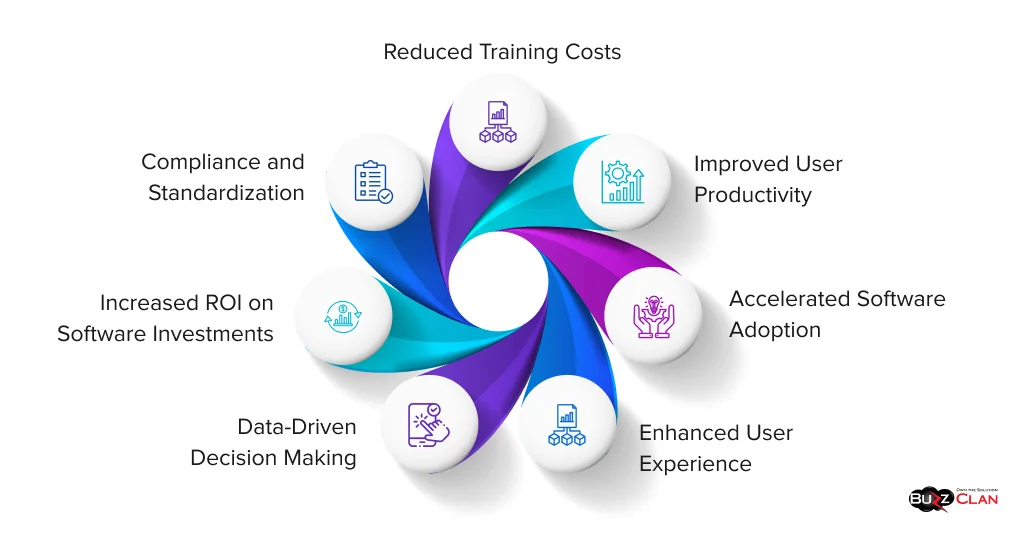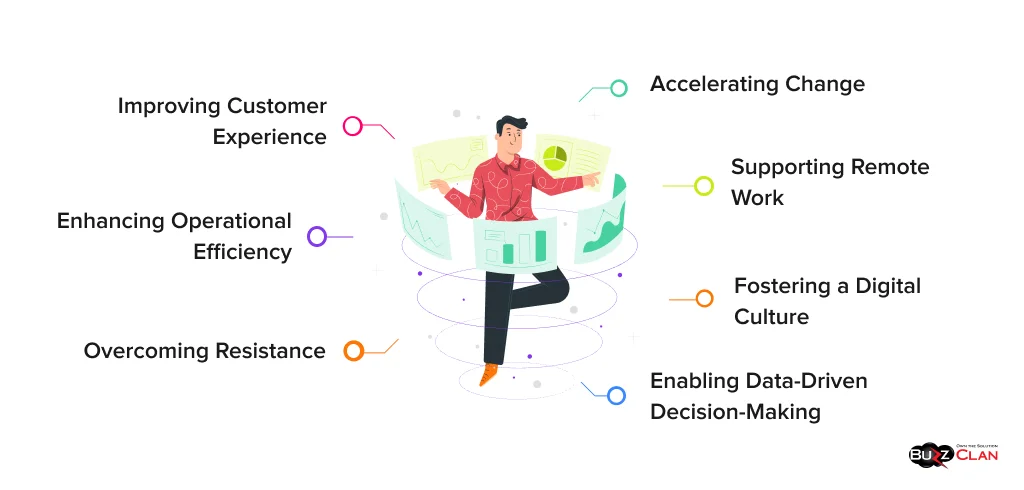Digital Adoption Platforms (DAPs): Revolutionizing Software Implementation and User Engagement
Anjali Agrawal
May 23, 2025
In today’s rapidly evolving digital landscape, organizations face the constant challenge of implementing new technologies and ensuring their workforce can effectively utilize these tools. Enter the Digital Adoption Platform (DAP) a game-changing solution transforming how businesses approach software adoption and user engagement. This comprehensive guide will delve into DAPs, exploring their features, benefits, and impact on modern enterprises.
Understanding Digital Adoption Platforms
Digital Adoption Platforms, often called DAPs, are innovative software solutions designed to streamline the process of adopting and mastering new digital tools and technologies. These platforms bridge complex software applications and end-users, providing interactive guidance, contextual help, and analytics to enhance the overall user experience and improve productivity.
At its core, a digital adoption platform is an overlay that sits on top of existing software applications, offering users real-time assistance and training as they navigate various tasks and workflows. This on-demand support system ensures that employees can effectively utilize new software from day one, reducing the learning curve and minimizing disruptions to business operations.
Key Features of Digital Adoption Platforms
- In-App Guidance: DAPs provide step-by-step walkthroughs and tooltips that guide users through complex processes within the application. This feature is handy for onboarding new employees or updating existing software.
- Contextual Help: Users can access relevant information and support materials directly within the application, eliminating the need to switch between multiple resources or consult external documentation.
- Analytics and Insights: DAPs offer detailed analytics on user behavior, task completion rates, and common pain points. This data helps organizations identify areas for improvement and optimize their digital adoption strategies.
- Personalized Learning Paths: Advanced DAPs can create customized learning experiences based on individual user roles, skill levels, and preferences, ensuring that each employee receives targeted training and support.
- Multi-Platform Support: Many digital adoption platforms are designed to work across various applications and devices, providing a consistent user experience across an organization’s entire digital ecosystem.
- Content Creation Tools: DAPs often include features that allow administrators to create and update guidance content quickly without requiring extensive technical knowledge or coding skills.
Benefits of Implementing a Digital Adoption Platform

- Accelerated Software Adoption: By providing immediate, contextual guidance, DAPs significantly reduce the time it takes for users to become proficient with new software applications. This accelerated adoption process translates to faster returns on investment for organizations implementing new technologies.
- Improved User Productivity: With on-demand support and streamlined workflows, employees can complete tasks more efficiently, increasing productivity across the organization.
- Reduced Training Costs: Digital adoption platforms minimize the need for extensive in-person training sessions and support staff, resulting in substantial business cost savings.
- Enhanced User Experience: By offering personalized guidance and support, DAPs create a more positive and less frustrating experience for users, leading to higher satisfaction rates and better overall engagement with digital tools.
- Data-Driven Decision Making: The analytics provided by DAPs offer valuable insights into user behavior and software utilization, enabling organizations to make informed decisions about their digital strategies and investments.
- Increased ROI on Software Investments: Organizations can maximize the return on their technology investments by ensuring that employees can effectively use all implemented software features.
- Compliance and Standardization: DAPs help enforce best practices and standardized procedures across an organization, ensuring consistency and compliance with internal policies and external regulations.
Choosing the Right Digital Adoption Platform
Selecting the appropriate digital adoption platform software for your organization is crucial to ensure successful implementation and maximize benefits. Here are some key factors to consider when evaluating DAP solutions:
- Compatibility: Ensure that the DAP is compatible with your existing software ecosystem and can integrate seamlessly with your current applications. Look for platforms that offer a wide range of integrations with popular enterprise software, such as CRM systems, ERP platforms, and productivity suites. Consider both current and future software needs to ensure long-term compatibility.
- Customization Options: Look for flexible customization platforms that allow you to tailor the guidance and content to your specific organizational needs. This includes the ability to create custom walkthroughs, tooltips, and help content that reflects your company’s branding, terminology, and unique processes. Advanced DAPs may offer features like custom CSS styling and API access for deeper integrations.
- Analytics Capabilities: Evaluate the depth and breadth of analytics the platform offers, as this data will be crucial for measuring success and identifying areas for improvement. Look for DAPs that provide detailed user engagement metrics, task completion rates, and feature adoption trends. Advanced analytics features include user segmentation, predictive analytics, and the ability to export data for further analysis in other business intelligence tools.
- User Interface and Experience: Choose a DAP with an intuitive interface that administrators and end-users can navigate and utilize effectively. The platform should offer a clean, unobtrusive design that enhances rather than disrupts the user experience of the underlying software. Consider platforms that offer different guidance formats, such as interactive walkthroughs, tooltips, and searchable knowledge bases, to cater to various learning preferences.
- Scalability: Consider your organization’s growth trajectory and select a platform to scale alongside your business needs. This includes handling an increasing number of users, supporting multiple applications and languages, and adapting to evolving software environments. Look for DAPs that offer flexible pricing models and the ability to add or remove features as your needs change.
- Support and Training: Assess the level of support and training provided by the DAP vendor, as this can significantly impact the success of your implementation. Look for vendors that offer comprehensive onboarding, ongoing technical support, and resources for best practices. Some providers may also offer consulting services to help optimize your digital adoption strategy.
- Security Features: Ensure the platform meets your organization’s security requirements and complies with relevant data protection regulations. This includes data encryption, user authentication, and role-based access controls. Organizations in regulated industries should look for DAPs that offer compliance certifications (e.g., GDPR, HIPAA, SOC 2) and the ability to host data in specific geographic regions if required.
- Content Creation and Management: Evaluate the platform’s content creation tools and how easy it is to develop, update, and manage guidance content. Look for features like WYSIWYG editors, content versioning, and the ability to clone and modify existing content. Some advanced DAPs may offer AI-assisted content creation or the ability to import content from other sources.
- Multi-language Support: For global organizations, consider DAPs that offer robust multi-language support, including the ability to create and manage content in multiple languages and automatically detect user language preferences.
- Mobile Compatibility: If your organization uses mobile applications, ensure that the DAP can provide guidance and support across desktop and mobile interfaces, offering a consistent experience across all devices.
Implementing a Digital Adoption Platform: Best Practices
To maximize the benefits of a digital adoption platform, consider the following best practices during implementation:
- Define Clear Objectives: Establish specific, measurable goals for your digital adoption initiative, such as reducing training time or increasing feature utilization rates. Use the SMART (Specific, Measurable, Achievable, Relevant, Time-bound) framework to set objectives that align with your overall business goals.
- Involve Stakeholders Early: Engage key stakeholders from various departments to ensure the DAP addresses diverse needs across the organization. This may include IT, HR, training and development, and line-of-business managers. Create a cross-functional team to oversee the implementation and ensure buy-in from all levels of the organization.
- Create Engaging Content: Develop clear, concise, and engaging guidance content that resonates with your user base and aligns with your organizational culture. Use various formats, such as interactive walkthroughs, short video tutorials, and quick reference guides. Tailor content to different user roles and skill levels and use plain language to ensure clarity.
- Prioritize User Feedback: Regularly solicit and incorporate user feedback to improve the DAP experience and address pain points. Implement a systematic feedback loop, including surveys, focus groups, and in-app feedback mechanisms. Use this input to refine content, adjust guidance strategies, and prioritize feature requests for the DAP.
- Leverage Analytics: Utilize the platform’s analytics capabilities to monitor usage patterns, identify areas for improvement, and measure the impact of your digital adoption efforts. Set up dashboards to track key performance indicators (KPIs) such as user engagement rates, task completion times, and support ticket reduction. Use these insights to make data-driven decisions about your digital adoption strategy.
- Promote Continuous Learning: Encourage a culture of continuous learning and improvement by regularly updating content and introducing new features to keep users engaged. Implement gamification elements, such as badges or leaderboards, to incentivize ongoing learning and exploration of software features.
- Integrate with Existing Processes: Align the DAP implementation with your existing onboarding, training, and support processes to create a cohesive digital adoption strategy. This may involve updating HR policies, revising training curricula, and adapting IT support workflows to incorporate the DAP as a primary resource for user assistance.
- Phased Rollout: Consider implementing the DAP in phases, starting with a pilot group or a specific department before rolling it out to the entire organization. This approach allows you to gather feedback, refine your strategy, and address issues before a full-scale deployment.
- Champion Network: Establish a network of “digital champions” or power users across different departments who can promote the use of the DAP, provide peer support, and serve as a bridge between end-users and the implementation team.
- Regular Content Audits: Conduct periodic audits of your DAP content to ensure it remains accurate, relevant, and aligned with current software versions and business processes. Establish a content governance framework to manage updates and maintain consistency across all guidance materials.
Case Studies: Digital Adoption Platforms in Action
To illustrate the real-world impact of digital adoption platforms, let’s explore a few case studies from different industries:
Global Financial Services Firm
- Challenge: A large multinational bank struggled to adopt a new customer relationship management (CRM) system across its global workforce of over 50,000 employees.
- Solution:The bank implemented a digital adoption platform that provided contextual guidance within the CRM system, offered multilingual support, and delivered personalized learning paths based on employee roles.
-
Results:
– 40% reduction in training time for new hires
– 30% decrease in support tickets related to CRM usage
– 25% increase in CRM feature utilization within six months
– Estimated cost savings of $2.5 million in the first year due to improved productivity and reduced support needs
E-commerce Retailer
- Challenge: A rapidly growing e-commerce company was experiencing high turnover rates among its customer service representatives, partly due to the complexity of its proprietary order management system.
- Solution: The company deployed a DAP that offered interactive walkthroughs, a searchable knowledge base, and real-time performance support within the order management system.
- Results:
– 50% reduction in onboarding time for new customer service representatives
– 35% improvement in first-call resolution rates
– 20% increase in employee satisfaction scores
– 15% reduction in employee turnover within the first year of implementation
Healthcare Provider Network
- Challenge: A large healthcare provider network was implementing a new electronic health record (EHR) system across multiple hospitals and clinics, facing resistance from medical staff due to the system’s complexity.
- Solution: The network implemented a DAP that provided step-by-step guidance for common EHR tasks, offered compliance-related alerts, and collected user feedback for continuous improvement.
- Results:
– 60% reduction in EHR-related errors within the first three months
– 45% decrease in time spent on administrative tasks by medical staff
– 30% increase in patient data completeness and accuracy
– Significant improvement in physician satisfaction with the EHR system
These case studies demonstrate the versatility and effectiveness of digital adoption platforms across various industries and use cases. DAPs can significantly improve software adoption, user productivity, and overall business performance by providing contextual support, personalized guidance, and data-driven insights.
The Role of Digital Adoption Platforms in Digital Transformation

Digital adoption platforms play a crucial role in broader digital transformation initiatives. As organizations increasingly rely on technology to drive innovation and competitive advantage, adopting new digital tools becomes paramount. Here’s how DAPs contribute to digital transformation efforts:
- Accelerating Change: DAPs help organizations implement new technologies faster by reducing employees’ time to become proficient with new tools. This acceleration enables businesses to be more agile and responsive to market changes.
- Overcoming Resistance: By providing immediate, contextual support, DAPs help alleviate user frustration and resistance to new technologies, making the transition to digital processes smoother and more widely accepted.
- Enabling Data-Driven Decision-Making: DAPs’ analytics offer valuable insights into user behavior and software utilization, enabling organizations to make informed decisions about their digital strategies and investments.
- Fostering a Digital Culture: By promoting continuous learning and self-service support, DAPs help cultivate a culture of digital fluency and adaptability within the organization.
- Improving Customer Experience: As employees become more proficient with digital tools, they can provide better customer service, improving customer satisfaction and loyalty.
- Enhancing Operational Efficiency: DAPs help streamline processes by guiding users through optimal workflows, reducing errors, and automating repetitive tasks.
- Supporting Remote Work: In the era of distributed teams, DAPs provide critical support for remote employees who may need more immediate access to in-person IT support or training resources.
Further Reading
Challenges and Limitations of Digital Adoption Platforms
While digital adoption platforms offer numerous benefits, it’s important to be aware of potential challenges and limitations:
- Initial Investment: Implementing a DAP requires an upfront investment in financial resources and time. Organizations need to evaluate the potential ROI to justify the expenditure carefully.
- Content Creation and Maintenance: Developing and maintaining high-quality, up-to-date guidance content can be resource-intensive, especially for organizations with complex or frequently changing software environments.
- User Resistance: Some employees may resist using a DAP, preferring traditional learning methods or viewing the platform as an intrusion on their work processes.
- Overreliance on Guidance: There’s a risk that users may become overly dependent on the DAP’s guidance, potentially hindering their ability to problem-solve independently or adapt to software changes.
- Integration Complexity: For organizations with diverse software ecosystems, integrating a DAP across all applications can be challenging and may require custom development work.
- Data Privacy Concerns: DAPs’ analytics capabilities may raise concerns about employee privacy and data protection, particularly in highly regulated industries.
- Balancing Guidance and Workflow: Finding the right balance between providing helpful guidance and not disrupting the user’s workflow can be challenging and require ongoing adjustments.
Emerging Trends in Digital Adoption Platforms
As technology evolves, digital adoption platforms adapt to meet new challenges and opportunities. Here are some emerging trends to watch:
- AI-Powered Personalization: Advanced machine learning algorithms enable DAPs to offer increasingly personalized guidance based on individual user behavior, learning patterns, and job roles.
- Predictive Analytics: DAPs are beginning to incorporate predictive analytics to anticipate user needs, identify potential roadblocks, and proactively offer assistance before issues arise.
- Voice-Activated Assistance: Integration with voice recognition technology allows users to access DAP guidance and support through voice commands, enhancing accessibility and convenience.
- Augmented Reality (AR) Integration: Some DAPs are exploring using AR to provide immersive, visual guidance for complex tasks, particularly in industries like manufacturing or healthcare.
- Emotion Recognition: Emerging technologies in emotion recognition allow DAPs to detect user frustration or confusion and adjust guidance accordingly.
- Integration with Robotic Process Automation (RPA): DAPs are beginning to work with RPA tools to guide users through human and automated processes.
- Expanded Use in Customer-Facing Applications: While primarily focused on internal software adoption, DAPs are increasingly applied to customer-facing applications to improve user onboarding and reduce churn.
Conclusion
Digital adoption platforms represent a powerful tool in the modern organization’s technology arsenal. By bridging the gap between complex software applications and end-users, DAPs enable businesses to maximize digital investments, boost productivity, and create a more engaged and tech-savvy workforce. As the digital landscape continues to evolve, the role of digital adoption platforms in driving successful digital transformation initiatives will only grow in importance.
Whether you’re implementing a new enterprise-wide system or seeking to optimize your existing software utilization, a well-chosen and effectively implemented digital adoption platform can be the key to unlocking your organization’s full digital potential. By embracing this innovative technology, businesses can stay ahead of the curve and thrive in an increasingly digital world.
As organizations continue to navigate the challenges of digital transformation, DAPs will play an increasingly critical role in ensuring that technology investments translate into tangible business value. By providing contextual guidance, personalized learning experiences, and data-driven insights, digital adoption platforms are not just facilitating software adoption – they’re empowering employees, driving innovation, and shaping the future of work.
FAQs

Get In Touch
